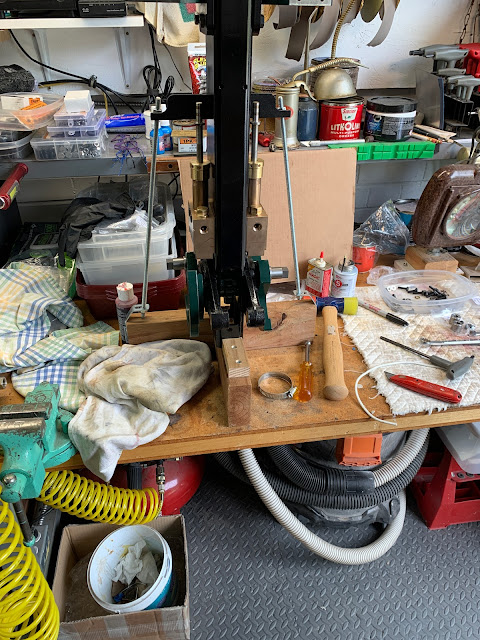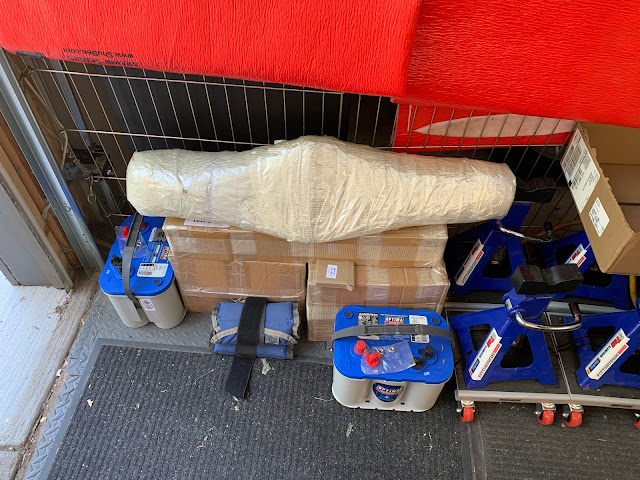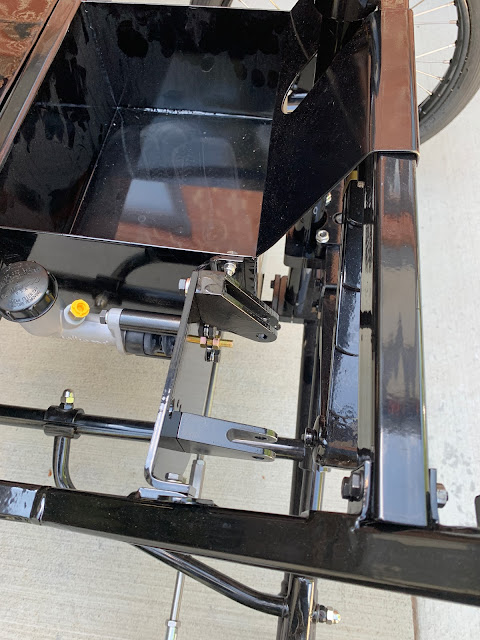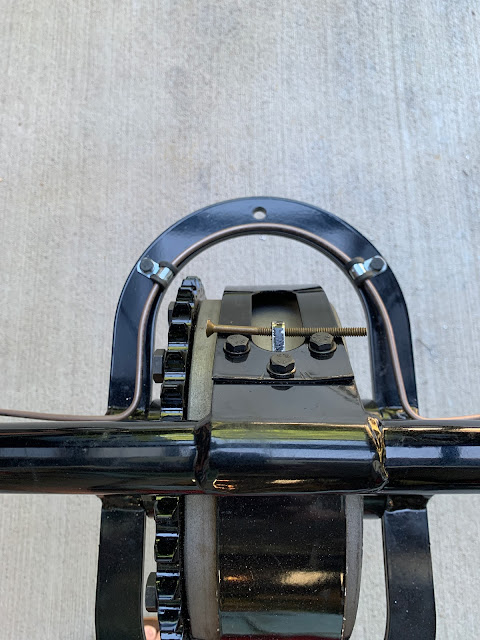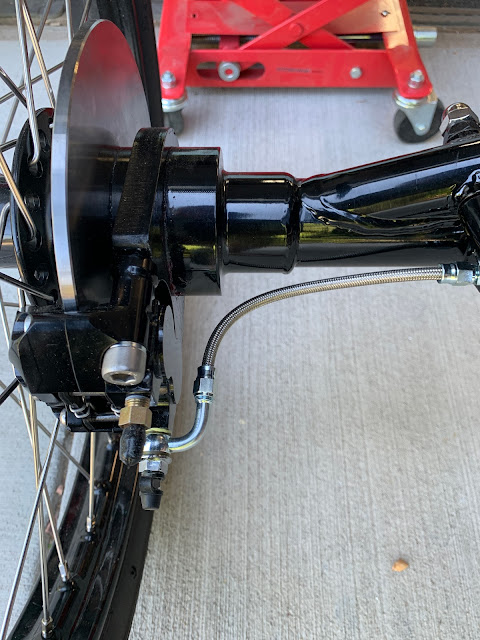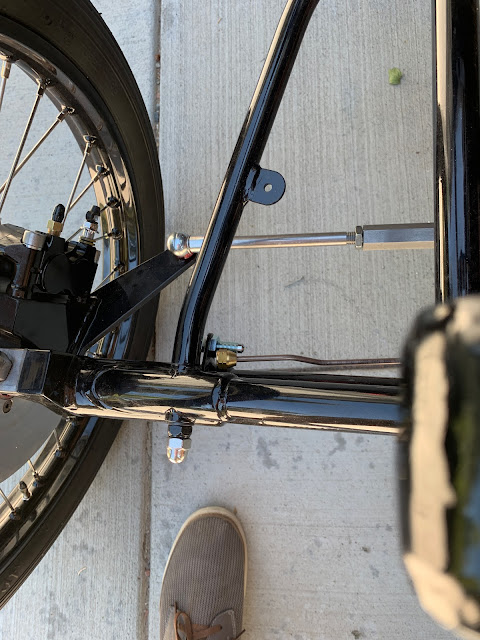Kits 11, 12, 13
Now that the crankshaft and webs are in place, the engine can sit on the stand and be built up in place. I know that it will need to go into the chassis at some time, but at least the during the initial build and test, it can be on the bench.
Kit 11 also contained the cylinders and base plates. I painted the cylinders BRG and the plates black. The flathead screws used to attach one to the other needed to be ground flat with the plate in order to sit on the post correctly. Since you do not want the screws to work loose in any manner, I used a punch to dimple the edge of the screw head as well as RED Threadlocker.
So at this point we are done with Kit 11.
Kit 12
Kit 12 is all about the pistons and pumps. We have the pistons on the piston rods, crossheads, crosshead guides, connecting rods, covers, gland packing and dual water pumps to put together and fit into place.
By now I have gotten in the habit of laying everything out and memorizing names in order to avoid the "what the hell is that thing" syndrome. It is better to have a name in your head, even if you spell it wrong, so you can look it up and check it's location on the drawings and in the text.
So I spent a lot of time putting pieces in order, connecting and disconnecting, and familiarizing myself with the order of assembly. This is all so I get things right-side-up and not inside-out. inserting the crosshead in the right direction helps when you are only holding things up with a fingernail while trying to get a bolt started.
Crossheads
The crossheads transfer the motion of the crank via the connecting rod to the piston. The big end of the connecting rod travels in a circle with the little end going up and down. The crosshead is confined to the crosshead guide and translates the movement to purely up and down. The crosshead also has a connector that drives the water pump.
The important part of all this is that there is a fairly close tolerance between the crosshead and the guide. The crosshead must move smoothly up and down and also survive slight rotational urges without binding.
Another important thing is that the crossheads are cast iron and the piston rods are stainless. Screwing one type of metal into another has been know to bind up and that would not be a good thing in this case. It would very very hard to get a grip on the crosshead or the piston rod without something getting marred.
To avoid this I re-tapped the crossheads to clean up the threads, using a little "Tap Magic" to lubricate.
Crosshead Guides
Due to the fact that the cylinders are rotated about 45 degrees off square and the cover bolt pattern is put on them identically during manufacturing, the guides are made to be RH/LH so that the crossheads and pump linkages all work correctly. So until you can work with everything upside down, it is a good idea to id them as you go. STW made this easy because they switched out manufacturing methods in the middle of my kits. One guide is cast iron, one is steel. I queried Lynn in support about this and was told that there was an issue with the foundry, in that they shut down, so there was a bit of a scramble to bring in another source, therefore, STW decided to change this part from CI to CRS.
To tell you the truth, once cleaned up, edges rounded the same, and surface sanded/buffed, the application of paint pretty much negated the differences.
Connecting Rods
Degreased, painted, bushes installed, bearings installed and all is ready to go. The only real adjustments was to the "little end" where it slid into the crosshead. I changed the radius of the little end to flatten it out a bit.
Pistons and Rods
The pistons were pre-installed on the rods and the retaining nuts were secured by additional punch-points in order to keep us builders from getting into trouble by having the pistons fall off in the middle of a run!
The rods are actually a little too long (1-2 threads) and needed to be ground down in order to avoid interference with the little ends of the connecting rods.
The piston rings were too tight in the grooves of the pistons. I used s sheet of emery paper on a granite tile to take them down to a nice slip fit in the grooves.
A couple of grooves in the Gudgeon Pin allows the grub screws to have something to bite into.
Last but not least, fitting the piston to the bottom cover with gland packing in place.
Water Pumps
There are two pumps in the system. Each is driven by the appropriate crosshead. You must just do the final assembly and adjust the little ball clearance. This is done by moving the head of a bolt up and down.
The pumps mount to the side of the main post right above the crankshaft. Watch your fingers - the edges are sharp. After catching mine, I took a small flap wheel to them (the edges not the fingers!).
So - At this point I have the sub-assemblies built and fitted. I am going to tweak some things like the gap in the piston rings and then read up on the next step in the process. I assembled both sides and worked on the alignment of the crossheads once the pistons are in place. Here is a final view before I take on Kit 13.
Kit 13 has all the timing and reversing components, so before I lock down Kit 11 and 12, I need to make sure Kit 13 does not impact anything.
So stand by,
Thanks for reading.
PoppaPope
Denver, Colorado USA
























